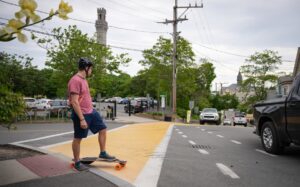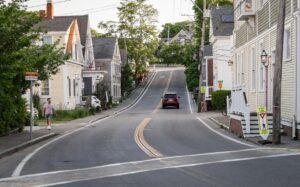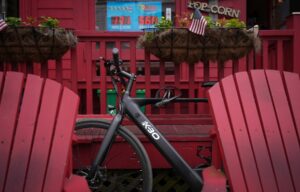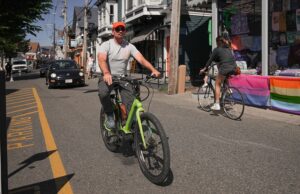PROVINCETOWN — Standing at the crosswalk on top of the hill where Bradford Street meets Prince Street, Michael Hart observes the flow of car traffic. “I’m never going down that hill again,” he says.

While commuting to work last August, Hart was knocked off his skateboard by a passing car’s sideview mirror at this intersection. The driver drove away without stopping, Hart says.
The narrow stretch of Bradford Street between Prince Street and Winslow Street has no bike lane and only one sidewalk, unlike many other parts of the thoroughfare. Many bikers and skateboarders avoid Bradford Street and instead travel on Commercial Street, where two-way bike traffic has been permitted for at least 46 years, even though it is one-way for cars and trucks.
All bicycle traffic on Commercial Street could potentially be restricted for part of the year, however, on the busy stretch between Center Street and Masonic Place. The select board is holding a public hearing on June 24 on a “walk only zone” that would require “anyone on a pedal bike, e-bike, scooter, or other similar wheeled or electric-powered device of any kind to dismount and walk through this area from Memorial Day to Labor Day each year.”
Cars, trucks, and electric wheelchairs would still be allowed to motor through the zone that was advertised in the public hearing notice, but cyclists going in either direction would need to walk their bikes through that corridor.
Bradford Street Blues
Bradford Street, and particularly the hill between Prince and Winslow, is not a new problem for cyclists. A town meeting vote in 1974 formalized the two-way traffic pattern for bicycles on Commercial Street, and votes in 1976 and 1978 established it as an exception to the state’s regular traffic laws, which require cars and bicycles to observe the same rules.

In 1990, town meeting voters passed Article 76, which resolved “to seek action by the Legislature to reinstate such exemption to permit two-way traffic by bicycles on Commercial Street should such action be required.”
Mary-Jo Avellar, now the town moderator, was finishing a 14-year stint on the select board when that meeting took place in 1990. She says that safety risks on Bradford Street are the reason the police chief and town manager at that time supported two-way bicycle traffic on Commercial Street.
“Riding a bike down the hill on Bradford Street is really difficult, and we didn’t want people getting hurt,” says Avellar. “The safest thing was to have bicyclists on Commercial Street.”
The town endorsed a new home-rule petition in 1991 requesting that its existing Commercial Street rules be protected in state law.
“It was about the danger of folks having to ride down the hill,” says Irene Rabinowitz, who served on the select board from 1990 to 1997. “Riding with traffic that close to cars going downhill was scary for a lot of people.”
Electric Vehicles
A recent proliferation of electric bicycles, scooters, skateboards, and other vehicles has had an effect on Commercial Street, however.
A serious accident last August sent a cyclist to Boston Medical Center for spinal surgery, and another crash in May sent a pedestrian to Cape Cod Hospital.
The two accidents happened within a block of each other: the first at Ryder Street near town hall, the second at Gosnold Street near Adams Pharmacy. Both intersections are within the select board’s proposed “walk only zone.”
In the May accident, the pedestrian, Provincetown homeowner Corey Johnson, was hit by a rider on an electric skateboard going against the flow of traffic on Commercial Street.
Powered devices are not allowed to go against the flow of traffic — a traffic hearing in July 2018 clarified that the exception for two-way travel on Commercial Street is extended only to non-electric bicycles.
Police Chief Jim Golden warned at that July 2018 meeting that the distinction between electric bicycles and regular bicycles would be hard to enforce.
“I do not have the staff, nor do I really think they should be focusing on every bicycle that goes by them, and is it being pedaled or is it making a faint whizzing noise,” Golden told the board at that hearing, according to a report in the Cape Cod Times.
Scooters and electric skateboards are significantly easier to detect, however, than the distinction between electric and regular bicycles. Enforcement of the town’s existing rules has been a repeated request of the select board, including at the May 13 meeting at which the board first discussed the walk zone.
Thoughts From Riders
Hart says he bought his electric skateboard so he could commute from his home in the East End to his job at Sol Optics in the center of town.
He also says he doesn’t feel safe using it during summer rush hours anymore.
“It feels like a waste of money because it’s unsafe to ride most of the year,” Hart says. “Early mornings and evenings aren’t too busy, but during a congested time, it’s impossible to ride safely through Commercial.”
Hart says he thinks the proposed walk zone on Commercial Street “would be really hard for the responsible people who do live here.” He suggested the limits should apply only in the daytime, perhaps from 10 a.m. to 5 p.m., so working people could still get to their jobs quickly.
Eddie Sanchez also commutes from the East End to his job at the bright-red Essentials store located next to the Canteen. He rides an electric pedal-assist bike and says he has been sideswiped by cars on both Bradford Street and Commercial Street.

Sanchez fell off his bike both times, he says; in the Bradford Street collision last summer, the driver didn’t stop.
Sanchez said he usually sticks to Commercial Street when he’s on his bike, because “there are so many side streets feeding onto Bradford,” he says. “Cars are coming out of nowhere.”
A walk-only zone “would be really hard for me,” says Sanchez. “I’m always busy working, needing to get around.”
Another electric bicycle rider, Derek McCormack, says that a walk-only zone on Commercial Street would lead to his using Bradford Street instead. He commutes from a condo on Shore Road in Truro to the Provincetown Bookshop next to Marine Specialties.

“For those who work in town, time is valuable and walking a bike is too great a hindrance,” says McCormack. “I would take Bradford far more often and minimize my travel on Commercial Street as much as possible.”
Chris Racine, who uses an electric bike or a Segway to get downtown from his home in the Harbor Hill apartments, says he uses Bradford Street when he’s in a hurry, “but there isn’t much protection” from cars there.

Racine says he is open to the select board’s proposed walk zone, but wants to know why cars would not also be restricted.
The rules that the select board advertised in advance of Monday’s hearing do not restrict cars, which means no such restrictions could be passed on June 24 since they were not publicly advertised in advance of the meeting.
